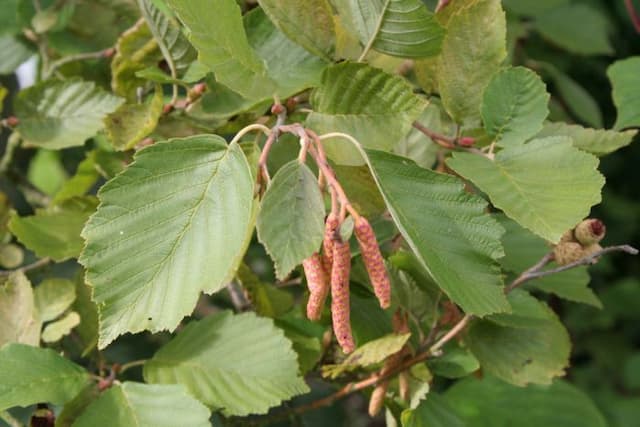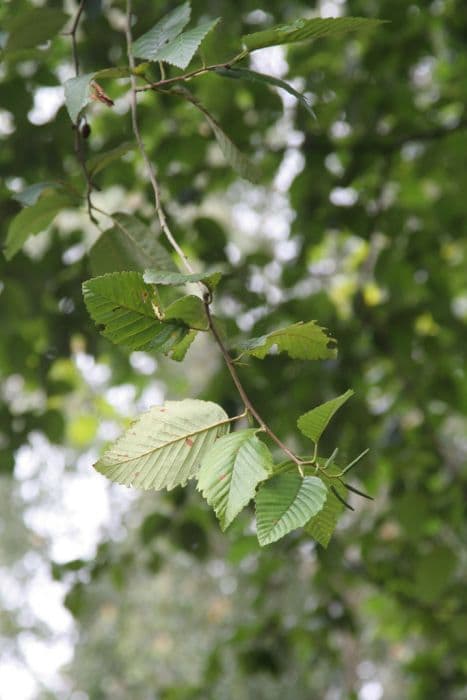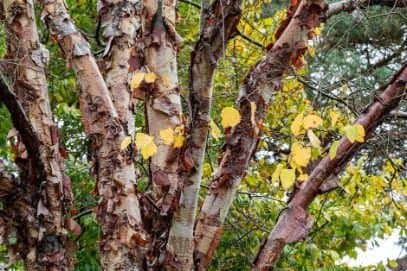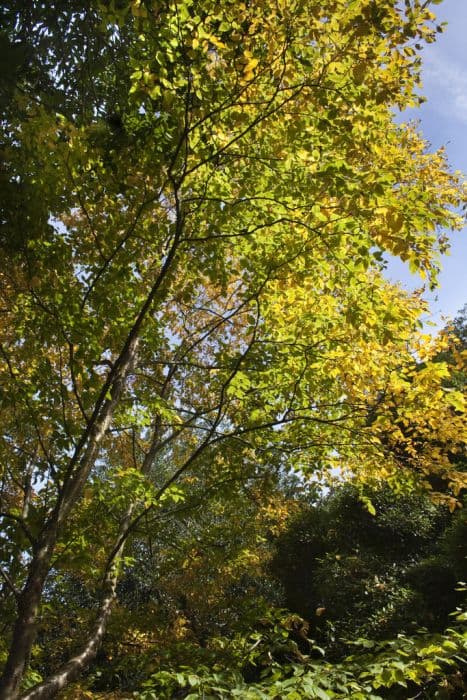Red Filbert Corylus maxima 'Red Filbert' (F)

ABOUT
Red Filbert is a deciduous shrub known for its striking foliage and edible nuts. The plant features heart-shaped leaves that emerge in hues of purple and red, making it stand out among green foliage. As the seasons change, the leaves may transition to a lush green, still with undertones of red, especially along the veins. In late winter or early spring, before the leaves unfurl, Red Filbert produces long, yellowish male catkins, which dangle elegantly from the branches, contrasting with the darker twigs and adding a touch of interest to the garden during the colder months. Following the catkins, female flowers develop, which are less conspicuous but crucial for nut production. These flowers are tiny and red, often nestled within the buds along the branches. By late summer or early autumn, the Red Filbert bears fruit in the form of nuts, encased in a husk with a papery outer layer tinted in hues of red and green. These nuts, commonly known as filberts or hazelnuts, are a favorite for wildlife and can be harvested for human consumption. The overall form of the Red Filbert is typically bushy and rounded, with a dense branching habit that provides substantial foliage coverage. Its textured bark and twigs add an additional layer of visual interest, especially during the dormant season when the leaves have fallen. This shrub is versatile in landscaping, often used as a focal point for its colorful foliage and contribution to wildlife habitats. The Red Filbert's combination of ornamental appeal and functional fruit production makes it a valuable addition to many gardens.
About this plant
 Names
NamesFamily
Betulaceae.
Synonyms
Red Filbert, Giant Filbert, Hall's Giant, Red Hazel, Purple-leaved Filbert, Red-leaved Hazel.
Common names
Corylus maxima, Corylus maxima var. purpurea.
 Toxicity
ToxicityTo humans
Red Filbert is not commonly known to be toxic to humans. Generally, the nuts of the Red Filbert, or hazelnuts, are edible and are commonly consumed. However, like any nut, they can cause an allergic reaction in some individuals, which can range from mild to severe including symptoms like itching, swelling, difficulty breathing, or anaphylaxis. It is essential for individuals with nut allergies to avoid consuming these nuts to prevent allergic reactions.
To pets
Red Filbert is not specifically listed as toxic to pets, which includes dogs and cats. The nuts of the Red Filbert, hazelnuts, are not considered toxic to these animals, but they could potentially cause digestive upset if consumed in large quantities or could pose a choking hazard or an obstruction risk. As with any non-pet food, it is always prudent to be cautious when it comes to your pets eating things outside of their normal diet. As always, if there is any concern about a pet having ingested something potentially harmful, it is best to consult a veterinarian immediately.
 Characteristics
CharacteristicsLife cycle
Perennials
Foliage type
Deciduous
Color of leaves
Green
Flower color
Yellow
Height
15 feet (4.57 meters)
Spread
10 feet (3.05 meters)
Plant type
Shrub
Hardiness zones
4
Native area
Europe
Benefits
 General Benefits
General Benefits- Aesthetic Value: The Corylus maxima 'Red Filbert', commonly known as Red Filbert, adds striking visual interest to gardens with its unique red foliage and catkins that appear in the spring.
- Nut Production: Provides an edible harvest of hazelnuts, which are enjoyed by both humans and wildlife.
- Wildlife Habitat: Supports local ecosystems by providing food for birds, squirrels, and other wildlife species.
- Shade and Shelter: Its canopy offers shade and shelter in the landscape which can be beneficial for understory plants and resting sites for wildlife.
- Seasonal Interest: Displays eye-catching color changes throughout the seasons from red or purple leaves in spring to green in summer, then to yellow in the fall.
 Medical Properties
Medical PropertiesThis plant is not used for medical purposes.
 Air-purifying Qualities
Air-purifying QualitiesThis plant is not specifically known for air purifying qualities.
 Other Uses
Other Uses- Red Filbert wood can be employed in fine woodworking and cabinetry, valued for its unique coloration and grain patterns.
- In artisanal crafts, the ornamental catkins (long, decorative flowers) can be used in floral arrangements or dried for decorations.
- The vibrant leaves of Red Filbert provide autumn interest in landscape paintings and photography, lending a seasonal aspect to artistic works.
- Red Filbert shells can be crushed and used as a natural mulch in gardening, providing soil nutrients as they decompose.
- The husks from the nuts can be repurposed into biodegradable sponges or scrubbers for household cleaning.
- When pruning, the flexible branches can be woven into fences, trellises, or garden structures, practicing traditional coppicing techniques.
- Red Filbert can be used in educational settings as a botanical specimen to study plant genetics, particularly for traits such as leaf color and growth habits.
- The plant can serve as a natural dye source, with the leaves and bark offering shades of yellow, green, and brown for textiles and crafts.
- As a habitat plant, Red Filbert provides nesting materials and shelter for birds, and its nuts are a food source for wildlife.
- In culinary arts, the blooms of the Red Filbert can be candied and used as edible decorations for desserts and pastries.
Interesting Facts
 Feng Shui
Feng ShuiThe plant Red Filbert is not used in Feng Shui practice.
 Zodiac Sign Compitability
Zodiac Sign CompitabilityThe plant Red Filbert is not used in astrology practice.
 Plant Symbolism
Plant Symbolism- Protection: Hazelnuts, which 'Red Filbert' produces, have traditionally symbolized protection. In folklore, hazel trees were thought to ward off evil spirits.
- Wisdom: The hazel tree, from which the 'Red Filbert' cultivar comes, has also been associated with wisdom and knowledge, as hazelnuts were believed to impart wisdom and inspiration.
- Fertility: Hazelnuts are often linked to fertility and abundance, making 'Red Filbert' a symbol of the potential for new growth and prosperity.
- Reconciliation: Because hazel trees have the ability to grow intertwined with one another, they symbolize reconciliation and peace.
- Divine Connection: In some cultures, hazel branches were considered a medium for divination and connecting with the divine, suggesting that 'Red Filbert' carries an aspect of spiritual communication.
 Water
WaterThe Red Filbert, commonly known as Hazelnut, generally requires regular watering to maintain moist, but not waterlogged, soil. During the growing season in spring and summer, water the plant once or twice a week, depending on weather conditions, providing about 1-2 gallons each time to ensure the soil is moist to the depth of the roots. Reduce watering in the fall and further in the winter when the plant is dormant, but do not allow the soil to dry out completely. Be cautious of overwatering as it may lead to root rot. It's essential to adjust the frequency and amount of water based on rainfall and temperature, as the plant can suffer from both underwatering and overwatering.
 Light
LightRed Filbert prefers a spot that offers full sun to partial shade. The ideal location would expose the plant to at least six hours of sunlight daily, ensuring strong growth and good nut production. If grown in too much shade, the plant may produce fewer nuts and have reduced foliage density. However, some afternoon shade in extremely hot climates can be beneficial to prevent scorching of the leaves.
 Temperature
TemperatureRed Filbert plants are hardy and can tolerate a wide range of temperatures. They survive in temperatures as low as 20°F and can endure cold winters. The ideal growing temperatures for Hazelnuts range between 60°F and 80°F. Red Filbert trees can also withstand high temperatures but may require additional watering during exceptionally hot periods to keep them stress-free.
 Pruning
PruningHazelnuts require pruning to maintain their shape, remove any dead or diseased wood, and encourage healthy new growth. Prune in late winter or early spring before new growth starts, removing up to one-third of the oldest wood and any crossing branches to improve air circulation. Regular pruning also helps in yielding better quality nuts by allowing more light to penetrate the canopy of the tree. The best time for pruning Red Filbert is during the plant's dormant period.
 Cleaning
CleaningAs needed
 Soil
SoilThe best soil mix for Red Filbert, commonly known as Hazelnut, should be well-drained, fertile, and rich in organic matter with a pH between 6.0 and 7.0. A blend of loamy garden soil, compost, and sand or perlite would provide the appropriate texture and nutrients.
 Repotting
RepottingRed Filbert trees, also known as Hazelnut, typically do not require frequent repotting when planted in the ground. However, if grown in containers, young trees may need repotting every 2 to 3 years to accommodate their growing roots and prevent becoming pot-bound.
 Humidity & Misting
Humidity & MistingRed Filbert, or Hazelnut, favors moderate humidity levels commonly found in temperate outdoor environments but does not thrive on specific humidity demands, handling a wide range as long as proper watering practices are maintained.
 Suitable locations
Suitable locationsIndoor
Not ideal indoors; needs ample space and light.
Outdoor
Plant in full sun, well-drained soil, space generously.
Hardiness zone
4-9 USDA
 Life cycle
Life cycleThe life of the Red Filbert (Corylus maxima 'Red Filbert') begins with seed germination, typically in spring under the right temperature and moisture conditions. The seedling develops into a young plant with a single stem, establishing itself with a rudimentary root system. As it matures, it develops into a multi-stemmed shrub with heart-shaped, red-tinged leaves, and by late winter to early spring, it produces long, yellow male catkins and small red female flowers. Pollination occurs, commonly aided by the wind, leading to the development of the characteristic hazelnuts, which mature by late summer or early fall and are concealed within a leafy husk. After nut fall, the plant enters a period of dormancy during winter, conserving its energy and resources until the next spring when the cycle begins anew with new growth and flowering. This cycle repeats annually, with the Red Filbert living for many years and reaching full maturity within 4-8 years, after which it can produce a full crop of nuts annually.
 Propogation
PropogationPropogation time
Late winter
Propogation: The most popular method for propagating Corylus maxima 'Red Filbert', commonly known as Red Filbert Hazel, is through hardwood cuttings. Hardwood cutting propagation typically takes place in late fall or early winter after the tree has gone dormant and shed its leaves. Cuttings should be taken from the current year's growth, choosing healthy twigs that are about the thickness of a pencil. Generally, cuttings should be about 8 to 10 inches (20 to 25 cm) in length. The lower end of the cutting is dipped in rooting hormone to enhance root development and then planted in a well-drained propagation medium. The top end is often sealed with wax to prevent desiccation. The cutting is further kept in a cool, humid environment to encourage root growth before being transplanted outdoors in the spring.









